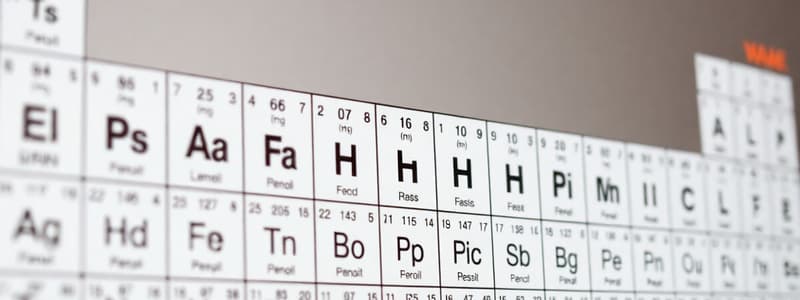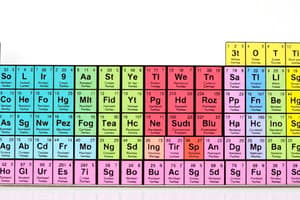Podcast
Questions and Answers
What information does the atomic number of an element represent?
What information does the atomic number of an element represent?
- The number of protons in the atom's nucleus (correct)
- The column number of the element in the table
- The number of neutrons in the atom's nucleus
- The total number of electrons in the element
Which of the following accurately describes the electron configuration in the periodic table?
Which of the following accurately describes the electron configuration in the periodic table?
- It shows the total number of electrons in the atom.
- It provides details about the valence electrons only. (correct)
- It indicates the overall charge of the element.
- It includes information on the number of protons.
What do the groups in the periodic table primarily illustrate?
What do the groups in the periodic table primarily illustrate?
- The number of neutrons in each element
- The color-coding scheme for the elements
- The atomic mass of each element
- The element's chemical properties (correct)
Which of these statements about the periodic table is true?
Which of these statements about the periodic table is true?
What is the role of the groups in the arrangement of the periodic table?
What is the role of the groups in the arrangement of the periodic table?
Flashcards
Periodic Table
Periodic Table
A table organizing elements in rows and columns based on properties.
Symbol
Symbol
A one or two-letter abbreviation for an element's name.
Atomic Number
Atomic Number
The number of protons in an atom's nucleus, unique to each element.
Group Number
Group Number
Signup and view all the flashcards
Electron Configuration
Electron Configuration
Signup and view all the flashcards
Study Notes
Periodic Table of Elements
- The periodic table organizes elements based on their atomic structure and properties.
- Elements are arranged in increasing atomic number.
- Elements in the same column (group) share similar chemical properties.
- Elements in the same row (period) have increasing numbers of electron shells.
Element Properties
- Group Numbers: Correspond to the number of valence electrons.
- Valence Electron Numbers: Indicate how many electrons an atom can gain or lose to form chemical bonds; listed in light blue or gray under the element in the table.
- Examples: Carbon (C) has valence electrons 2, 4; Oxygen (O) has 2, 6; Nitrogen (N) has 1, 3, 5; Silicon (Si) has 2, 4; Fluorine (F) has 1; Sodium (Na) has 1; Magnesium (Mg) has 2.
Element Names and Symbols
- Elements are represented by a one- or two-letter symbol (e.g., H for Hydrogen, O for Oxygen).
- The name of the element is also given next to the symbol; some in Spanish and some in English.
Studying That Suits You
Use AI to generate personalized quizzes and flashcards to suit your learning preferences.




